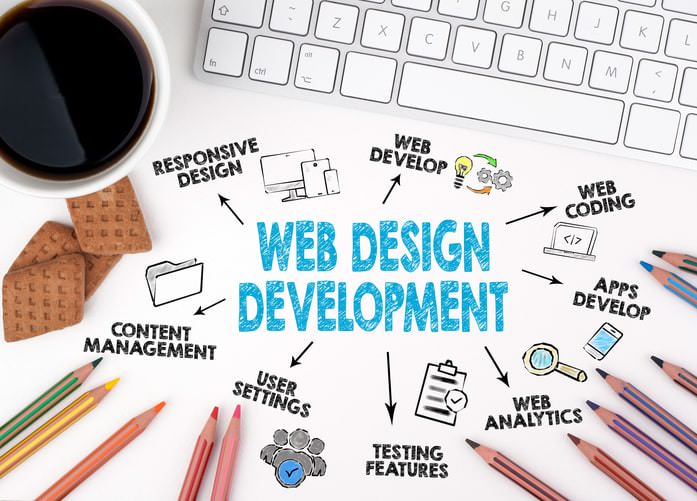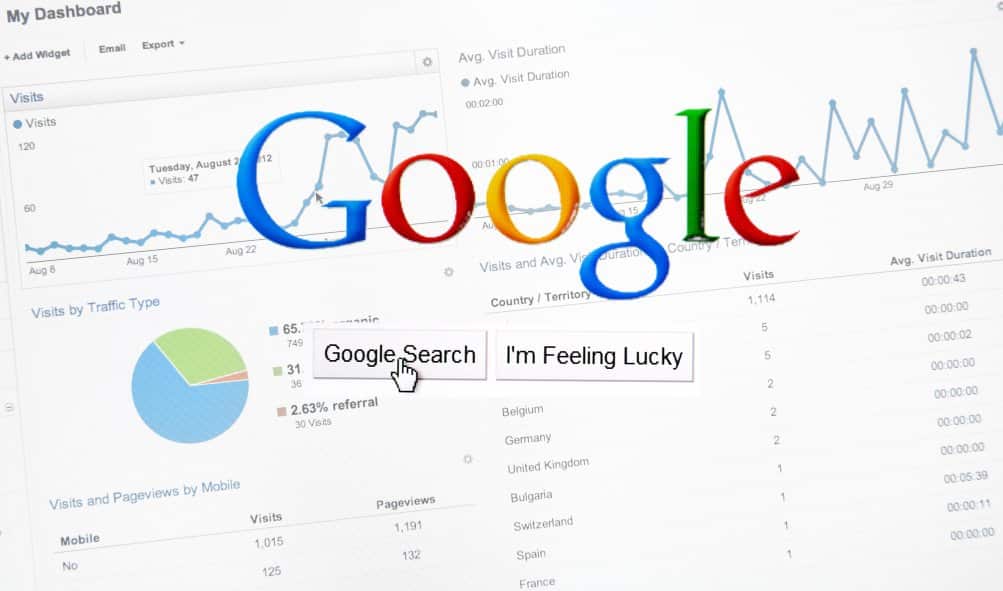Webolutions – Over Two Decades of Website Design and Development Excellence
After nearly 24 years of owning a web design company, providing enterprise-level website design and development as a full-service digital marketing agency, I thought it would be beneficial to share some this history with those newer to the industry.
Reason dictates that the further you can look back into the history of something (like digital marketing for example), the better suited and prepared you are to understand the current industry trends and where things are heading. There are cycles and trends which allow those with a longer history to better anticipate and meet future needs.
As web design and website development systems continue to evolve at an escalating rate, with new strategies and flavors of the month, it is more important than ever for businesses to understand the fundamentals of a successful website and not jump at every shiny new object.
Hopefully, you will find this overview interesting, and the perspective will help you better identify and understand the opportunities which can give your web design and business a competitive advantage now and into the years, to come.
Websites – The Evolution
 In 1994, when I founded Webolutions, websites looked very different than they do today. The World Wide Web had just become accessible to the general public in 1993.
In 1994, when I founded Webolutions, websites looked very different than they do today. The World Wide Web had just become accessible to the general public in 1993.
Because it was created as a tool to share hypertext linked documents (thus the term Hypertext Markup Language or HTML) within a geographically diverse scientific community, websites were a lot of text with links to additional pages which also contained a lot of text. It was common knowledge among users that any text on a web page, which was underlined and shown in reflex blue was a link on which you could click to go to another page for additional information.
The 56k modem was invented in 1996. This device used your home or office LAN line to connect you to the internet. Who remembers this? While you were connected to the internet, you were unable to use your home LAN telephone line. 56k refers to the speed of the modem. With this power (ha ha) you could download 56,000 bits of data per second. There are 1000 bits in a Kilobit (KB) and 1000 KBs in a Megabit (MB) and 1000 MBs in a Gigabit (GB). So, the 56k modem, “high-speed” capacity delivered .056KB (yes, 5% of KB) per second speed for your website viewing experience. Today’s cable modem speeds range from 4 to 12 Mbps. Without doing the math, let’s just say things are a lot faster.
The first image was uploaded on a website in 1992, so images have always been a part of the web design experience. However, because the internet was only accessible to most via a dial up modem, images on websites had to be a very small file size and their use per web page had to be limited.
You may find this article helpful: Top Questions to Ask a Web Developer Before Hiring
From 1994 to 2001, all the websites we created were individual pages, coded by hand. Each web page contains several hundred lines of code which provide instructions to the web browsers used by visitors. To hyperlink a word in a sentence to another page in a website or to a different website, the code we typed was <a herf=”www.sitetolinkto.com”>words to link</a>. In the early website browsers like Netscape 1.0, if you miss-paced something or if you forgot the ending tag, not only wouldn’t the hyperlink work, the whole web page might not show up. The next step would be to go line-by-line through the code and find where the error may have occurred. Fun!!
Today, all websites and website development is still done using basically this same underlying html code base. The browsers have advanced greatly and are far more forgiving. Plus, many websites are now created using website editors or out-of-the-box templates. So, there is very little hand coding happening.
While website editors and customizable templates make the creation of a good-looking website a heck of a lot easier, they also create a multitude of unforeseen and potentially devastating issues for unknowledgeable businesses. To help explain, let’s dig a little deeper. Some of the key factors, of a successful website for many businesses include:
- A clean, fresh and engaging experience for website visitors
- The ability for the website to score well on search engines
- The ability to add new features and functionality to the site
- The ability to A/B test website and continually improve results
Many available website builders (Wix, Square Space, etc..) allow for the quick, easy and cheap (even free) creation of a website. They have templates into which content is inserted and editing tools which allow for the selection of colors and fonts. For the Jr. High lawn mowing business or home craft business, who simply needs an online brochure, these are great web design tools.
The issue with using a website builder, out-of-the-box WordPress premium template or other tools that make good looking, cheap and easy websites, is that these tools were not created for effective online marketing. Their underlying code base often contain hundreds or even thousands of “extra” lines of code. This code provides the website owner a multitude of attractive design options and features. However, what most businesses do not realize, is that all this extra code adversely effects the website’s ability to rank well on Google.
 Google’s website ranking algorithm is complex. It analyzes and scores several complex factors (we may address some of these in follow up articles). But, the bottom line is that the underlying web development code used to build your website is a very important factor to how well your website is going to score in Google’s search results. We have never seen a builder generated site or template that generates code optimal for scoring well on the search engines. Plus, these tools do not allow for any tweaking or adjusting of the code to improve these possibilities.
Google’s website ranking algorithm is complex. It analyzes and scores several complex factors (we may address some of these in follow up articles). But, the bottom line is that the underlying web development code used to build your website is a very important factor to how well your website is going to score in Google’s search results. We have never seen a builder generated site or template that generates code optimal for scoring well on the search engines. Plus, these tools do not allow for any tweaking or adjusting of the code to improve these possibilities.
Also, if you want to add new features or functionality to a website builder site, this is not possible. These sites and templates are made to do what they do, and that is it. To add new features and functionality to an out-of-the-box template website is a complex and laborious exercise. The underlying code was created for plug and play ease of management, not for expansion. For clients who come to us with a completed template website, it is often faster for us to create a new custom website than to try and enhance (add new functionality) to a template website.
A/B website testing is also something which should continually occur on any website which is being marketed. This involves the serving of different versions of the website to different visitors to see which version yields the best results. If you do not have access to the website code base and the underlying website design files, conducting this sort of regular improvement activity is impossible.
When creating a custom website vs using a website builder or out-of-the-box template, WordPress has emerged as the leading website development tool for website companies. This CMS (Content Management System) is highly-flexibly and allows professional developers to create 100% custom websites on top of a robust content management system to allow website administrators to have full capability to edit the website content through a simple interface. In addition, if the website developer understands how to create URLs and the underlying page code for better rankings on Google, WordPress provides this level of code access. WordPress can also include custom integrations with over 15,000 plugins or via any third-party APIs or Web Services. These allow a custom WordPress website to integrate with inventory systems, reservation tools, CRMs, etc…
Web Design Strategies
 Over the past 24 years, it has been exciting playing a role in the evolution of web design. It has come leaps and bounds from primarily text pages and a few gifs (yes, these were sometimes animated) to an exciting, immersive world of beautiful imagery and videos. Of course, now the majority of the interactions with this content are now being done on high-resolution, mobile devices instead of the giant 40lb CRT monitors of we were once so proud.
Over the past 24 years, it has been exciting playing a role in the evolution of web design. It has come leaps and bounds from primarily text pages and a few gifs (yes, these were sometimes animated) to an exciting, immersive world of beautiful imagery and videos. Of course, now the majority of the interactions with this content are now being done on high-resolution, mobile devices instead of the giant 40lb CRT monitors of we were once so proud.
Without a doubt, the two biggest factors impacting the evolution of website design have been
- Increased Bandwidth
- Mobile Devices
Increased internet speeds have allowed us to convey business concepts and emotions in vibrant image-rich web designs. While fast load times are still critical for usability and search engine rankings, today’s speeds allow web design to tell a more immersive story through imagery and video.
The advent of mobile devices was also a game changer. Today, all web design has to be done to maximize the user experience in a responsive format. Responsive means that the web design is fluid. It is fluid and adjusts based on the size and resolution of the viewer’s individual screen. Elements of the design are programmed to rearrange, removed or redrawn to create the best user experience no matter what the device.
Mobile devices (first iPhone released June 29, 2007) have also blurred the line as to content needing to live, “above the fold”. In early web design, visitors rarely scrolled. So, everything important had to live in the top 800 or so pixels of the page. Our web designs today can provide a richer experience and tell a complete story. Visitors expect to scroll down the page on their phones and on desktop. This allows us to immediately deliver the most important information at the top of the page, yet let the website visitor discover other interesting information, thoughts and ideas as they scroll. This has broadened the playing field.
Web Development
Web 1.0, of course, were websites that conveyed information. Web 2.0 has ushered in websites that allow for the interaction of tasks and actions. They are rich with user-generated content. Today’s sites integrate information into interactive tools providing far greater value to visitors. Interactive information like reviews and client ratings combine, with XML, information sharing between sites to engage the visitor and create a better overall experience.
In this immersive, more sophisticated world, web design is often referred to UX (User Experience) referring to the overall experience a visitor is going to have with the website and IA (Information Architecture) referring to the organization of the information within the site. The guiding of a user, in the cleanest and simplest way possible, through complex information, has and always will be an art form. The expertise and experience to do this well is the difference between successful web development and a complete failure. At Webolutions, we are obsessive about turning the complex into something that looks clean, simple, easy and inviting. The only downside to our expertise in web development, is that the better you are at achieving this, the less work people may believe it took to get there. That is ok though! We love it!
The Future of Web Design and Web Development
Webolutions has always focused on the future of this industry. This is imperative to ensure we are guiding our clients towards the best ideas and solutions in Web Design and Web Development. Some of the top trends we believe are shaping this future are:
- Mobile
- Every mobile user has a direct GPS connection. Based on this information, their online experience can be tailored specifically for them. As systems are developed to utilize this information, we will continue to see localization playing a larger role in web development and the associated programming.
- Voice Search
- It is estimated that by 2020 up to 50% of all web searches will be voice search. This demands that web design and web development is done to take advantage of this trend. Instead of a paragraph of text or a picture, website content should be organized as to address a voice search question? We are already building tools to help take advantage of this fundamental consumer behavioral shift.
- Artificial Intelligence
- As we continue to share more of our personal information, and the online experience becomes more personalized though connected systems, a more personalized website experience will become expected. Web design and development of business websites will need to incorporate and utilize this information to mirror this type of highly personal interaction.
- Augmented Reality
- In a blended world of reality and instant information via virtual screens or information located wherever the visitor may choose, the way we interact with website will change completely. Imagine you can wear a lightweight device and motion with your hand to pull up a screen anywhere you choose. Then use gestures and your voice to find information. Watching these trends and seeing how this story unfolds will be truly interesting.
Your website has the potential to be a powerful business asset and tool. It should be working for you to drive exposure and engagement with your key audience(s). If you would like to learn more about how a business-minded approach to web development can help grow your business, please reach out to us for an initial consultation with one of our experts. Webolutions – 303-300-2464
- From Words to Pictures: Using ChatGPT and Dalle 3 to Improve Your Digital Marketing Campaigns - January 4, 2024
- Annual Plan Development – A Roadmap to Strategic Target Achievement - October 9, 2023
- Positioning Your Company for Greater Success - August 24, 2023



